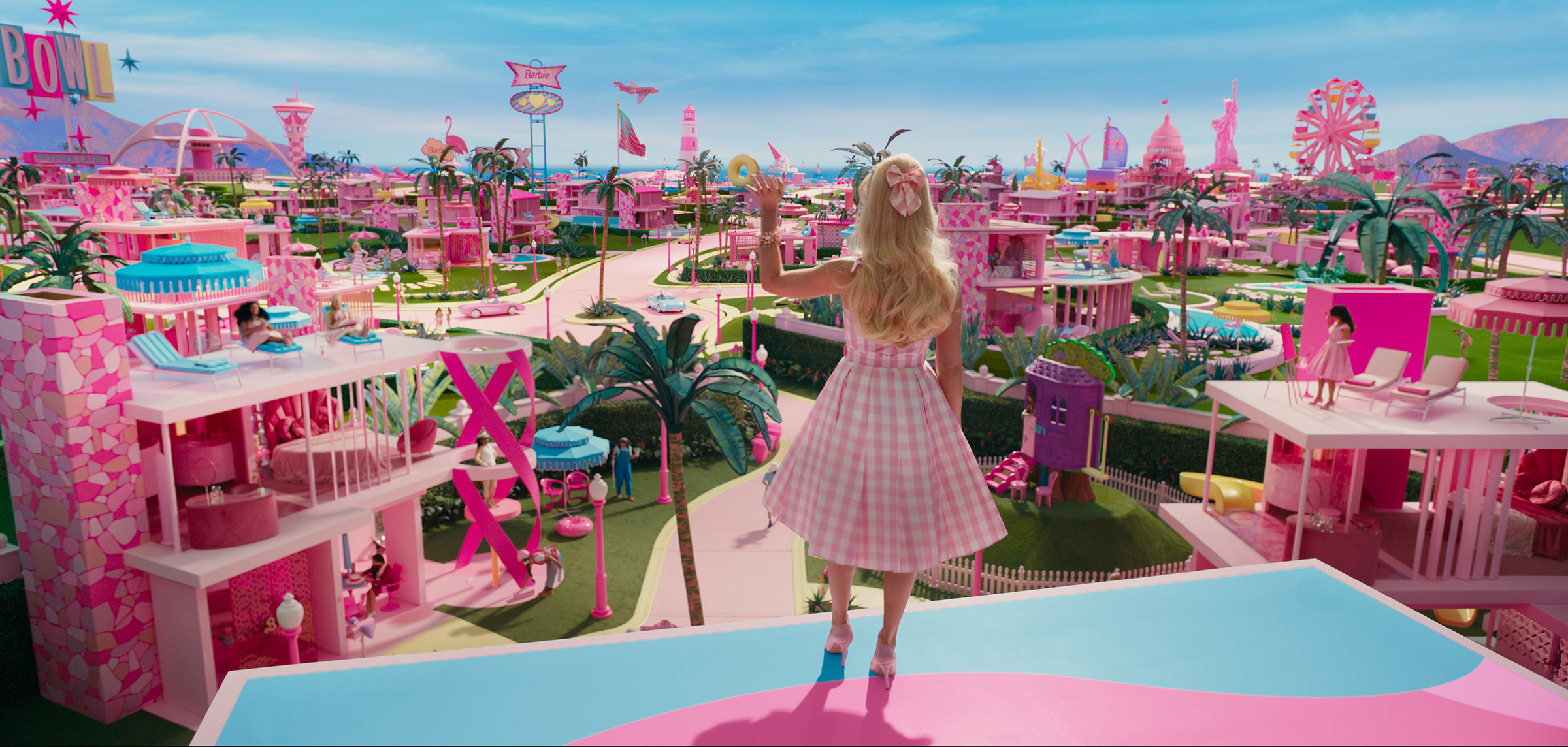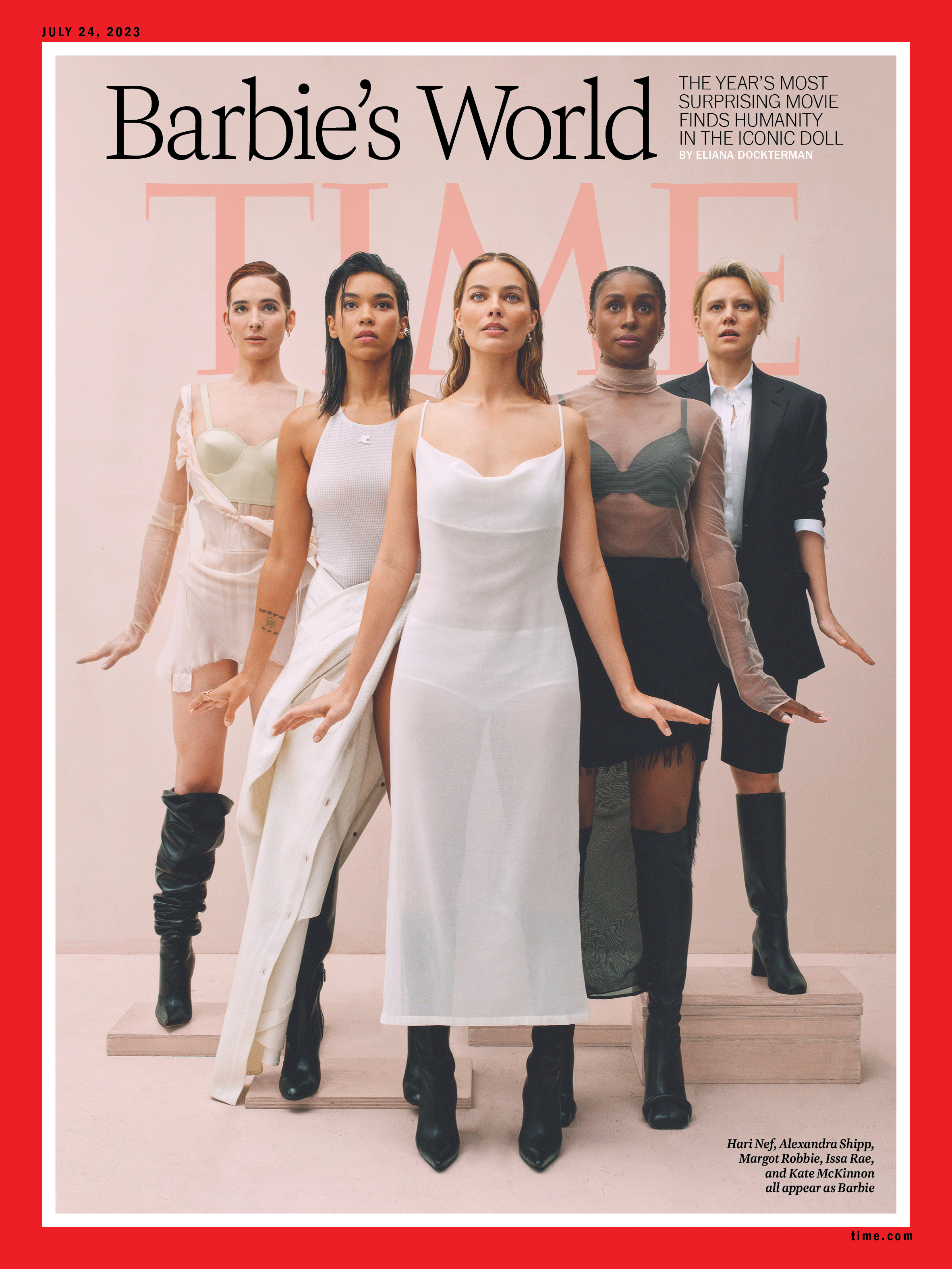
Barbie is a movie that benefits from multiple screenings. On every viewing, you’ll catch something different, whether it’s a big idea or a tiny detail. When it hits theaters on July 21, every person who has ever dressed a Barbie up is bound to recognize some outfit or prop from their childhood, whether they played with the doll in the 1960s or 1990s. And even the Barbie agnostic will find something to pick up, whether it’s references to the technicolor musicals of Old Hollywood or a famous scene from The Matrix.
Filmed primarily at a studio in London, the story of Barbie begins in a pink wonderland called Barbie Land where there’s an all-female Supreme Court, and, as Helen Mirren’s narrator tells the audience, “all problems of feminism and equal rights have been solved.” The Barbies celebrate their good fortune with nightly slumber parties. It’s a lived-in fantasy world that relies primarily on physical sets rather than CGI. To build out Barbie Land, writer-director Greta Gerwig decided to create a coherent set of rules that would govern how it looked and functioned. In order to do that, she dove into the history of Barbie, the history of movies, and the history of fashion. For a cover story on the new film, Gerwig, producer and star Margot Robbie, and creatives at Mattel spoke to TIME about how they dreamt up all the details in the film.
The Barbie team attended a Barbie bootcamp
Over the course of 2018 and 2019, Gerwig, Robbie, and folks from Robbie’s production company LuckyChap went through an immersion course designed by Mattel. The unofficial Barbie bootcamp began with the doll’s origin story—Barbie was created by Ruth Handler—and took a tour through some of Barbie’s best outfits over the years.
More from TIME
Read More: How Barbie Came to Life
This research served as inspiration for the story. Handler’s relationship with her daughter Barbara (after whom Barbie is named) manifested as a plot point involving a mother and daughter in the film. “A Barbie movie is only ever going to be a mother-daughter movie on so many levels because it was Ruth Handler and Barbara—that was the relationship,” says Gerwig.
Gerwig and filmmaker Noah Baumbach, her co-writer and partner, also had to build a world from scratch. They came up with rules for Barbie Land to keep everything coherent. “You see a seamless universe that all makes sense, and that’s because there were these very specific boundaries about what could and couldn’t happen,” says Kate McKinnon, who plays one of the Barbies. One such rule? Barbie Land is a utopia, so nothing can be cluttered. There is no trash. “Nothing is dirty in the world, even when it gets its most chaotic,” says McKinnon. “I was struck by that.”
Barbie’s 1950s origins inspired the Dream House aesthetic
Given that Barbie first came to market in 1959, Gerwig and Oscar-nominated production designer Sarah Greenwood decided to run with a midcentury modern aesthetic for Barbie’s Dream House and many of her fashions. Barbie lives on the sort of suburban cul de sac idealized in that era.
The Dream Houses were built without walls so the actors had to be attached to wires to make sure they didn’t topple off the top floors of their homes when they got out of bed. But the cast says everything else in their Dream Houses was surprisingly functional: They would sit on the retro chairs and hang out talking between takes. “We all just wanted to kick it in each other’s living rooms because they were so fabulous,” says Alexandra Shipp, who plays an author Barbie.
Read More: Why It Took 64 Years to Make a Barbie Movie
Skipper’s house is the only one on the block that’s purple instead of pink. Leaves are growing out of the roof, and a swing is tied to a protruding branch. Technically it is the Chelsea Tree House—nearly an exact replica, scaled up to fit human actors.
In fact, everything in Barbie Land is built to a specific scale to look “toyetic.” “The scale is not life-like,” says Lisa McKnight, the executive vice president at Mattel whose job is specifically to oversee the marketing of Barbie and dolls. For instance, Barbie the character’s Corvette is just a little too small for Robbie, just as Barbie the doll’s convertible is a little too small for her: The windshield only comes up to her chest.
Gerwig was influenced by Old Hollywood
Gerwig’s team didn’t just study midcentury furniture trends. The filmmaker also revisited the films of Old Hollywood to capture the look of those stories. Rather than using a green screen to ensure that there were only bright blue skies in idyllic Barbie Land, Gerwig’s team hand-painted the backdrops to look like old soundstage musicals. In an early scene, Ken tries to interact with a set backdrop with disastrous results.
Read More: Barbie’s Got a New Body
Many of the props on set were also painted by hand, from the trees to the pool that sits outside of Barbie’s Dream House and contains no water. “I remember even the bark of the palm trees had different shades of brown, green, and even pink,” says McKnight.
Barbie is filled with dance numbers that are heavily influenced by 1940s and 50s Technicolor musicals like Singin’ in the Rain. During filming, Robbie’s production company LuckyChap hosted a film festival of sorts playing movies that influenced Barbie.
But Gerwig didn’t limit herself to one era. The movie is stuffed with references to all sorts of films ranging from Rocky to 2001: A Space Odyssey to Clueless.
The devil in the tiny, pink details
Barbie Land comes to life in the details. Gerwig obsessed over it all, and the props that populate the fantastical space imbue it with a surprisingly lived-in quality, like a Barbie version of the book Moby Dick on a side table. All the letters in Barbie’s mailbox have been scribbled upon in a nonsense language, like a child might write.
Barbie devotees know that Pantone 219 is Barbie’s very specific shade of pink. A giant Pantone 219 chip sits outside the Barbie conference room at Mattel. But the set used so much pink paint—in that specific color as well as secondary and tertiary shades—that it precipitated a worldwide shortage. The sheer number of pinks in every shot presented their own challenge. “I don’t think we have seen or will ever see a film with more pink in it,” says producer David Heyman, who helped build another famous fantasy world with the Harry Potter film series. “And then how to handle that photographically—thank goodness we had Rodrigo Prieto, who was able to balance all that and create a beautiful and rich palette.”
Out now: TIME’s new special edition about Barbie is available at newsstands and here online
The soundtrack is filled with today’s top artists, but even the singers were chosen with intention. Issa Rae, who plays President Barbie, points out that Barbie’s image among adults has been buoyed in recent years by Nicki Minaj, who has adopted the name “Barbie” as one of her personas. Minaj, along with Ice Spice, are the ones remixing Aqua’s old “Barbie Girl” song in a wink to Barbie’s influence on music throughout the years. “My Barbie association is Nicki Minaj,” says Rae. “So it’s dope that she is a part of this movie in some way.”
Barbie’s fashion is (almost) always on point
Beyond the Barbie immersion course, Gerwig and Baumbach did their own deep dive to dig up even more details about particularly strange or controversial outfits or dolls Mattel produced over the years. Robbie’s Barbie and Ryan Gosling’s Ken donned collector’s items that we won’t spoil for superfans. And, yes, some of the stranger toys show up in the movie too. The marketing rollout has already revealed that the pregnant Midge doll who quite literally popped a baby out makes an appearance in the film. (Emerald Fennell has the honor of portraying the unusual toy.)
Read More: What to Know About Midge and Allan, the Deepest Cuts From the Barbie Movie
Oscar-winning costume designer Jacqueline Durran was charged with replicating some of Barbie’s most iconic looks. She had a direct line to Kim Culmone, the head of design for fashion dolls at Mattel, who in turn would dive deep into the archives to provide the filmmaking team with references. Every bathing suit and camp shirt was handmade and silk screened and completely custom. “Whether it’s 1950s ladylike attire or a Western Barbie and Ken look or the rollerblades, those looks stick out to me as really toyetic,” says Culmone. “And that was important because even though we were putting Barbie in the real world, there was always a commitment to serve the fans of Barbie with these toyetic references.”
But the specific touches are what truly made the set a work of art. At one point during the movie, Ken walks around in a pair of boxing shoes that are made specifically for smooth surfaces, which is fine because there’s no real grass, gravel, or dirt in Barbie Land.

More Must-Reads From TIME
- The 100 Most Influential People of 2024
- How Far Trump Would Go
- Scenes From Pro-Palestinian Encampments Across U.S. Universities
- Saving Seconds Is Better Than Hours
- Why Your Breakfast Should Start with a Vegetable
- 6 Compliments That Land Every Time
- Welcome to the Golden Age of Ryan Gosling
- Want Weekly Recs on What to Watch, Read, and More? Sign Up for Worth Your Time
Write to Eliana Dockterman at eliana.dockterman@time.com